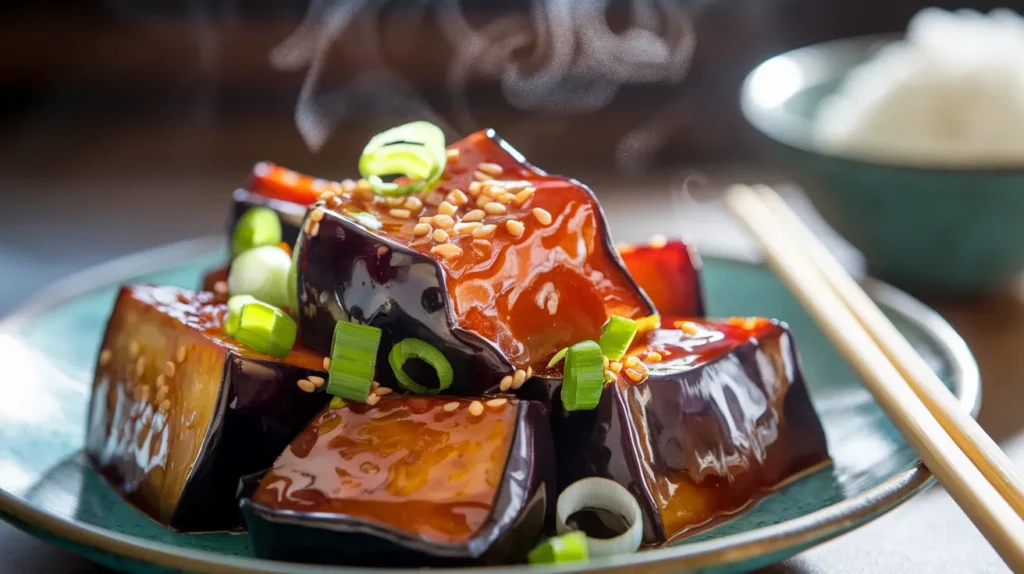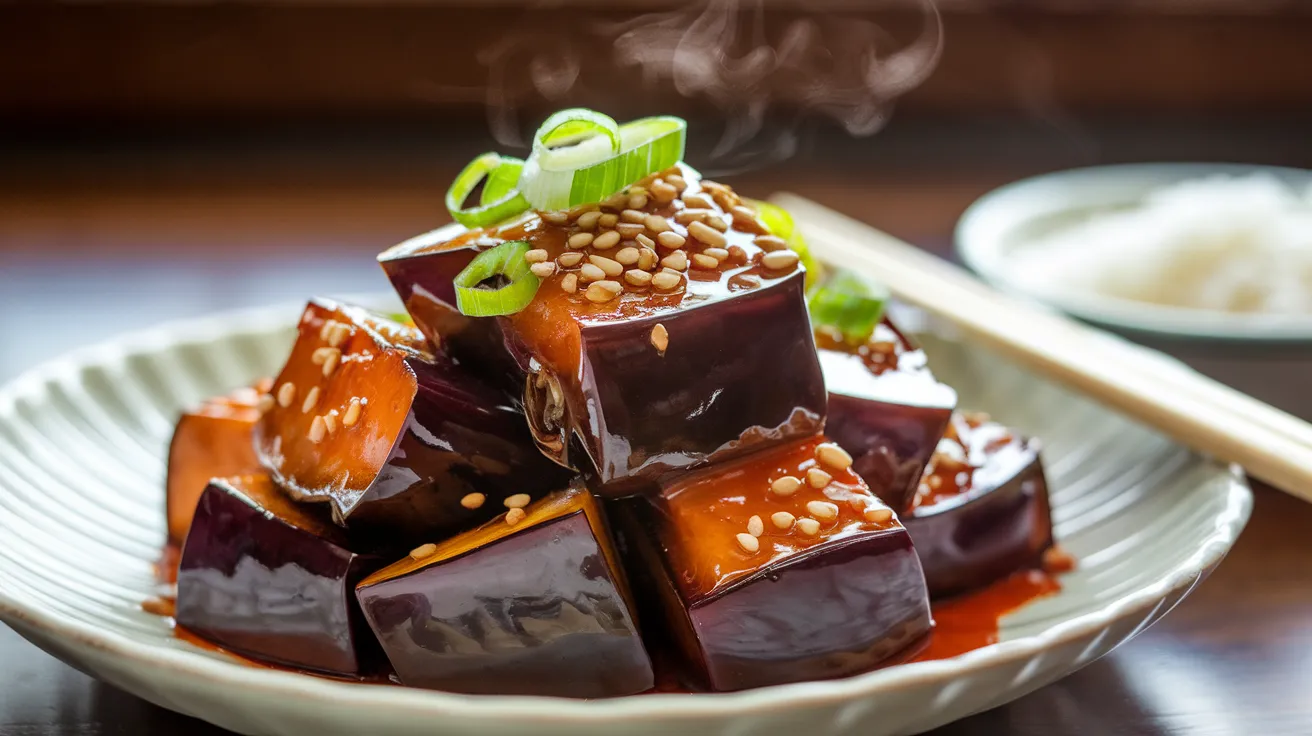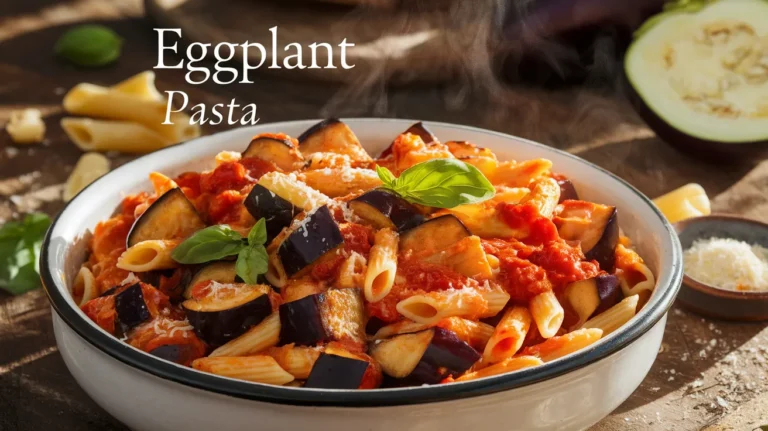This gochujang eggplant recipe transforms humble purple vegetables into a flavor-packed Korean-inspired dish that’s sweet, spicy, and absolutely addictive. Perfect for weeknight dinners, this gochujang eggplant combines the smoky depth of roasted eggplant with Korea’s beloved fermented chili paste for a meal that serves four and takes just 45 minutes from start to finish.
SERVES: 4 | PREP: 15 MIN | COOK: 30 MIN | TOTAL: 45 MIN
Ingredients
Main Components
| Ingredient | Amount | Notes |
|---|---|---|
| Large eggplants | 2 medium (about 2 lbs) | Choose firm, glossy skin |
| Gochujang paste | 3 tablespoons | Korean chili paste |
| Soy sauce | 2 tablespoons | Low sodium preferred |
| Rice vinegar | 1 tablespoon | Adds brightness |
| Sesame oil | 2 teaspoons | Toasted variety |
| Vegetable oil | 3 tablespoons | For roasting |
Aromatics & Garnish
| Ingredient | Amount | Notes |
|---|---|---|
| Fresh garlic | 4 cloves, minced | About 2 teaspoons |
| Fresh ginger | 1 inch piece, grated | Adds warmth |
| Green onions | 3 stalks, sliced | White and green parts |
| Sesame seeds | 2 tablespoons | Toasted for crunch |
| Brown sugar | 1 tablespoon | Balances heat |
Step-by-Step Instructions
Phase 1: Prep Work (10 minutes)
Step 1: Preheat your oven to 425°F (220°C). This high temperature ensures the eggplant gets beautifully caramelized edges while staying creamy inside.
Step 2: Wash and dry the eggplants thoroughly. Cut them into 1-inch cubes, leaving the skin on for texture and nutrients. The skin helps hold the pieces together during cooking.
Step 3: Place cubed eggplant in a large bowl and sprinkle with 1 teaspoon of salt. Toss well and let sit for 5 minutes. This draws out excess moisture and reduces bitterness.
Step 4: While eggplant sits, prepare your gochujang sauce. In a medium bowl, whisk together gochujang paste, soy sauce, rice vinegar, brown sugar, minced garlic, and grated ginger until smooth.
Phase 2: Roasting Setup (5 minutes)
Step 5: Pat the salted eggplant dry with paper towels. This step is crucial – wet eggplant will steam instead of roast, preventing that desired golden color.
Step 6: Drizzle vegetable oil over the eggplant cubes and toss until every piece is lightly coated. The oil helps achieve crispy edges and prevents sticking.
Step 7: Arrange eggplant in a single layer on a large rimmed baking sheet. Don’t overcrowd – use two sheets if necessary. Crowded vegetables steam and turn mushy.
Phase 3: First Roasting (15 minutes)
Step 8: Roast eggplant for 15 minutes, until edges start turning golden brown. The pieces should be tender when pierced with a fork but still hold their shape.
Step 9: Remove from oven and let cool for 2 minutes. This brief rest prevents the gochujang sauce from burning when added.
Phase 4: Glazing & Final Cook (10 minutes)
Step 10: Pour the prepared gochujang sauce over the roasted eggplant. Use a spatula to gently toss, ensuring every piece is coated with the glossy red sauce.
Step 11: Return to oven for 8-10 minutes more. The sauce should be bubbling and slightly caramelized around the edges. Watch carefully to prevent burning.
Step 12: Remove from oven when the sauce has thickened and the eggplant pieces are deeply glazed. They should look glossy and appetizing.
Phase 5: Finishing Touches (2 minutes)
Step 13: Drizzle sesame oil over the hot eggplant while it’s still on the baking sheet. This adds a nutty aroma that complements the gochujang beautifully.
Step 14: Transfer to serving platter and immediately sprinkle with sliced green onions and toasted sesame seeds. Serve hot while the sauce is still glossy.
Chef’s Notes
Eggplant Selection: Choose eggplants that feel heavy for their size with tight, glossy skin. Avoid any with soft spots or wrinkled areas, as these won’t hold up well during roasting.
Gochujang Heat Level: Start with less gochujang if you’re heat-sensitive. This fermented paste varies in spiciness between brands, so taste and adjust accordingly.
Oil Temperature: Make sure your oven is fully preheated before adding the eggplant. A hot oven creates the initial sear that locks in flavors and creates those coveted crispy edges.
Sauce Consistency: The gochujang eggplant sauce should coat the back of a spoon. If it’s too thick, thin with a tablespoon of warm water before tossing with eggplant.
Nutrition Information (Per Serving)
- Calories: 165
- Protein: 4g
- Carbohydrates: 18g
- Fat: 9g
- Fiber: 8g
- Sodium: 680mg
Delicious Variations
Mediterranean Fusion: Replace gochujang with harissa paste and add crumbled feta cheese. This creates a wonderful East-meets-West flavor profile that pairs beautifully with the eggplant’s natural earthiness.
Protein Addition: Transform this into a complete meal by adding cubed tofu or tempeh during the final 10 minutes of cooking. The protein absorbs the gochujang flavors wonderfully.
Vegetable Medley: Combine with other vegetables like zucchini and bell peppers. If you enjoy experimenting with eggplant dishes, try our eggplant zucchini bake for another satisfying vegetarian option.
Noodle Bowl Base: Serve over rice noodles or quinoa with extra sauce on the side. For meat lovers, consider pairing with our minced pork eggplant recipe for a heartier meal combination.
Storage & Reheating
Refrigeration: Store leftover gochujang eggplant in an airtight container for up to 4 days. The flavors actually improve overnight as the sauce penetrates the eggplant.
Reheating: Warm in a 350°F oven for 8-10 minutes, or microwave in 30-second intervals until heated through. Avoid overcooking, which can make the eggplant mushy.
Freezing: While possible to freeze for up to 2 months, the texture changes slightly. Thaw overnight in refrigerator before reheating.
Make-Ahead: Prep the sauce up to 3 days ahead and store covered in the refrigerator. Cut eggplant the morning of serving for best results.

Troubleshooting Common Issues
Problem 1 – Soggy Eggplant: This happens when eggplant isn’t properly salted or patted dry. Always salt cubed eggplant for 5 minutes, then thoroughly pat dry before oiling.
Problem 2 – Burnt Sauce: Gochujang contains sugars that can burn quickly. If your oven runs hot, reduce temperature to 400°F and watch carefully during the final glazing phase.
Problem 3 – Bland Flavor: Underseasoned gochujang eggplant usually needs more acid. Add an extra teaspoon of rice vinegar or a squeeze of fresh lime juice to brighten the flavors.
Problem 4 – Uneven Cooking: Cutting eggplant pieces to different sizes causes uneven cooking. Use a ruler if needed to ensure uniform 1-inch cubes for consistent results.
Problem 5 – Sauce Won’t Stick: This occurs when eggplant is too hot when sauce is added. Let roasted eggplant cool for 2-3 minutes before tossing with the gochujang mixture.
Equipment Essentials
- Large rimmed baking sheet (18×13 inch preferred)
- Sharp chef’s knife for clean eggplant cuts
- Cutting board with good grip
- Large mixing bowl for tossing
- Whisk for smooth sauce mixing
- Measuring spoons and cups
- Paper towels for patting dry
- Silicone spatula for gentle tossing
Shopping List
Produce Section
- 2 medium eggplants (about 2 lbs total)
- 1 piece fresh ginger (1-inch needed)
- 1 head fresh garlic
- 1 bunch green onions
Asian/International Aisle
- Gochujang paste (Korean chili paste)
- Sesame oil (toasted variety)
- Rice vinegar
- Sesame seeds (toasted preferred)
Pantry/Condiment Section
- Soy sauce (low sodium recommended)
- Brown sugar
- Vegetable oil
- Salt
Success Secrets
1. Salt Early, Pat Dry: The 5-minute salting step isn’t optional. It removes bitterness and excess moisture, ensuring your gochujang eggplant roasts beautifully instead of steaming.
2. High Heat is Key: Don’t reduce the oven temperature thinking it will prevent burning. The high heat creates the caramelization that makes this dish special.
3. Sauce Timing Matters: Add the gochujang sauce only after the first roasting phase. Adding it too early causes the sugars to burn before the eggplant is properly cooked.
4. Don’t Skip the Rest: Letting the roasted eggplant cool briefly before adding sauce prevents immediate burning and allows better sauce adherence.
5. Fresh Garnishes Transform: The final sprinkle of green onions and sesame seeds isn’t just decoration – they add crucial textural contrast and fresh flavor that completes the dish.
This gochujang eggplant recipe proves that simple ingredients can create extraordinary flavors. The combination of smoky roasted eggplant and Korea’s beloved fermented chili paste results in a dish that’s both comforting and exciting, perfect for introducing your family to bold new tastes.




